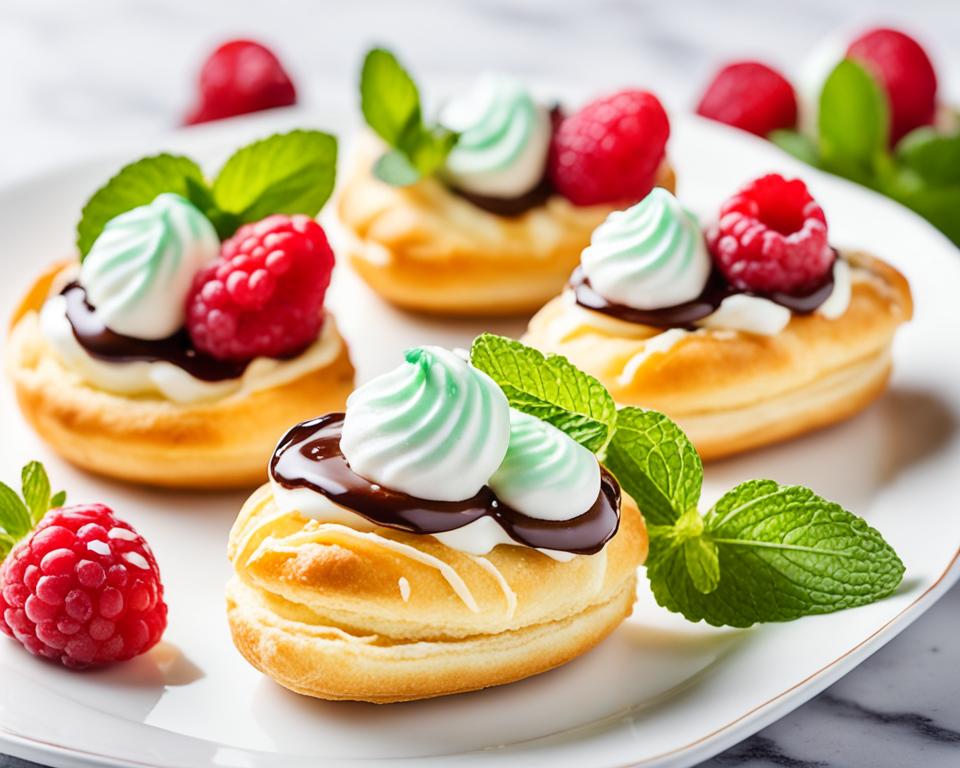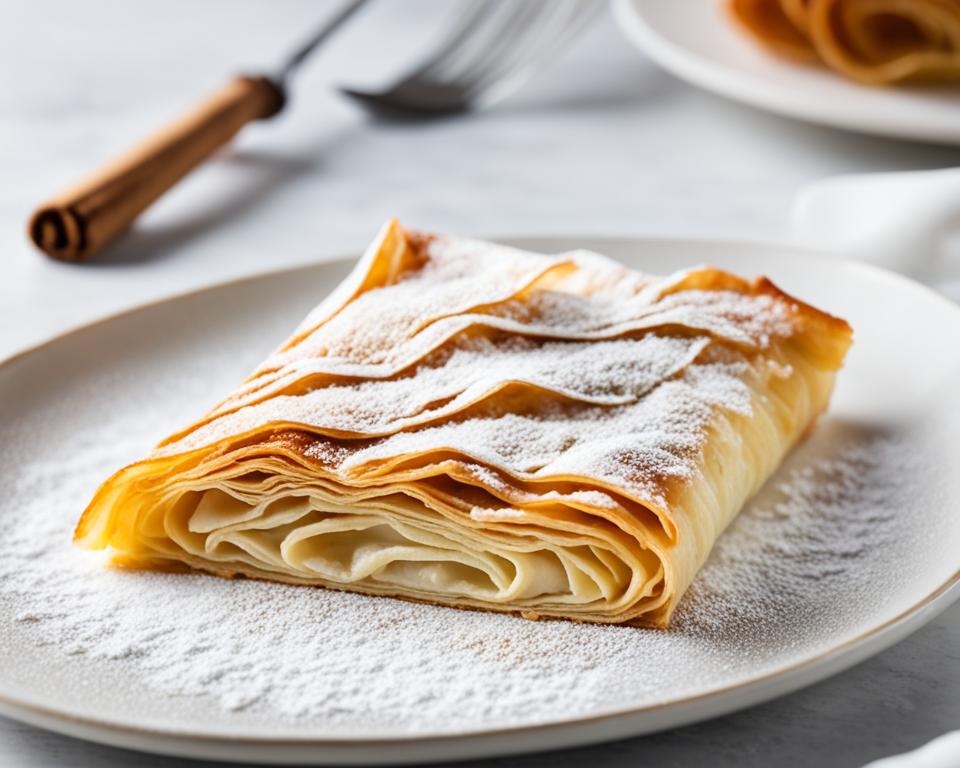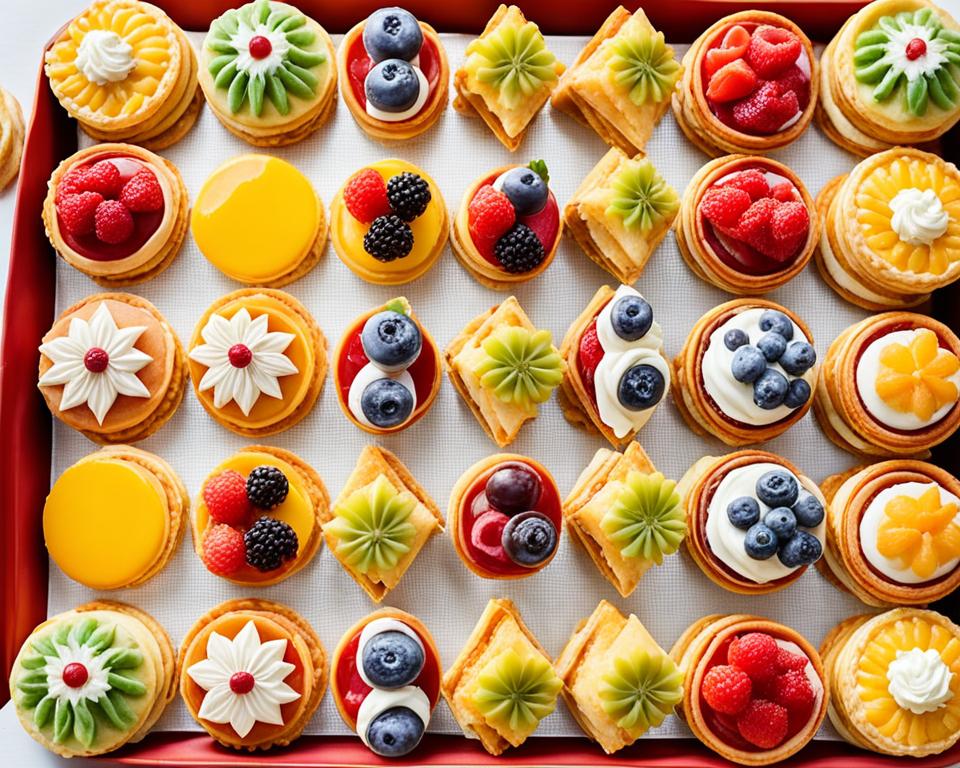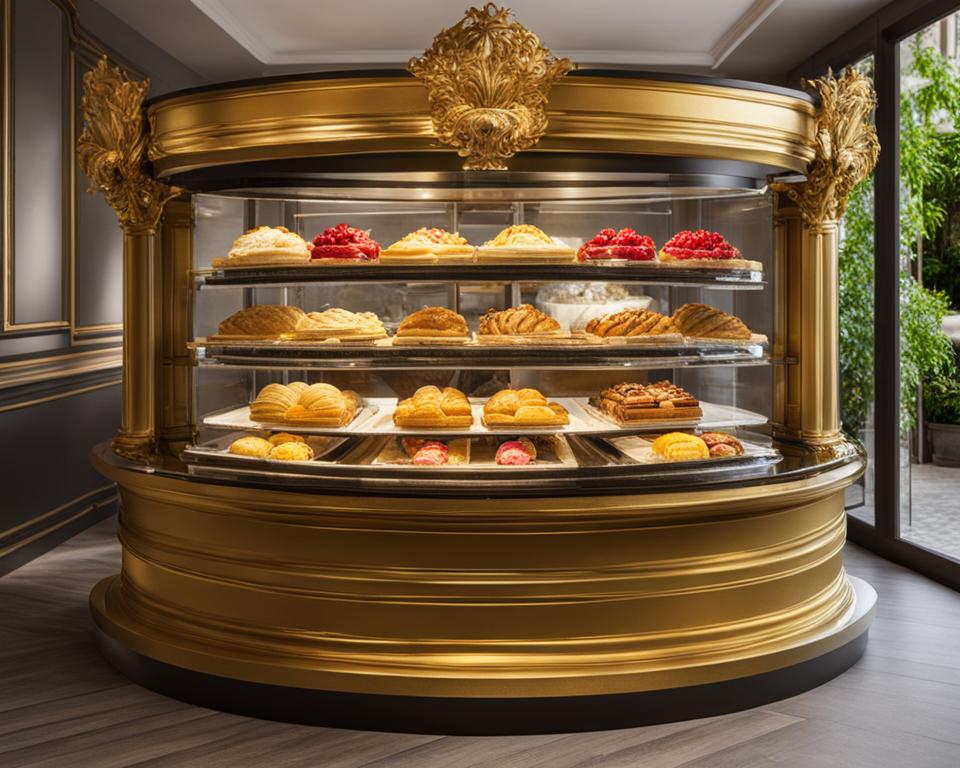In the rich tapestry of baked goods, the art of making pastries stands out as a testament to culinary diversity and creativity. Exploring the various types of pastries and desserts unveils a realm where simple ingredients such as flour, fat, and water transcend their humble beginnings, undergoing transformation through distinct preparation methods. The result? An array of different pastry types each boasting unique textures, flavors, and uses that are celebrated in both home kitchens and professional establishments alike.
Whether it’s the buttery layers of French Viennoiserie or the crisp elegance of Choux, each pastry style serves as a canvas for bakers to showcase their expertise and ingenuity. Understanding these pastry classifications not only enhances one’s baking repertoire but also deepens the appreciation of the cultural significance and history behind these edible masterpieces. Let us delve into the six types of pastry that are fundamental to the baking world and uncover the secrets behind what makes each one uniquely irresistible.
Key Takeaways
- Discover the six essential types of pastry foundational to the art of baking.
- Learn the unique preparation techniques that give each pastry style its distinctive texture and flavor.
- Appreciate the versatility of different pastry types in both savory and sweet culinary creations.
- Find inspiration in the variety of types of pastries and desserts that span across cultural cuisines worldwide.
- Recognize the importance of precise ingredient ratios and methods within the pastry classifications for perfect results.
Exploring the Art of Viennoiserie
The world of popular pastries is delightfully complex and varied, offering a cornucopia of flavors and textures that tantalize the taste buds of connoisseurs and casual eaters alike. French cuisine has a deep-seated tradition in the realm of baked goods, particularly those falling under the umbrella term of Viennoserie. It’s a domain where the perfect marriage of fat and flour gives rise to some of the most beloved pastry varieties.
Delicate, airy, and rich, these pastries not only serve as a source of gastronomic joy but also as artistic expressions of the bakers who craft them. The characteristic lamination process of folding butter into dough creates the delicate layers that make croissants the epitome of Viennoiserie. However, this much-revered category of pastry varieties extends to include a host of other delectable treats, each with its own tradition and taste. In this exploration, we traverse the heart of Viennoiserie, adorned with its acclaimed creations.
Croissants: A French Culinary Staple
When pondering over popular pastries, the croissant immediately comes to mind as the quintessential hallmark of French cuisine. Characterized by its buttery essence and light, flaky layers, the croissant is not just a morning delicacy but a cultural icon. The craft of creating the perfect croissant is a rite of passage in French pastry schools, serving as the fundamental technique that aspiring bakers are ardently encouraged to master.
With each fold and roll, butter weaves its way through the dough, creating the telltale pockets that puff up into golden crescents upon baking—a delightful testament to the baker’s skill and patience.
Danish, Brioche, and Pain au Chocolate: The Versatile Delights
The realm of Viennoiserie extends far beyond the humble croissant, encompassing a variety of other pastries that can match any mood or meal. Danish pastries come adorned with fruit or creamy fillings, resplendent under their sugary glazes. Brioche, with its tender crumb and slight sweetness, bridges the gap between the categories of bread and pastry—excellent when served warm and buttered or used as the base for sumptuous French toast.
Let us not forget the sublime Pain au Chocolat, rich with the enchantment of dark chocolate enveloped in layers of laminated pastry. Synonymous with comfort and indulgence, it holds a treasured spot in the pantheon of pastry varieties. These pastries, while diverse in their fillings and forms, are united in their technique of careful, precise lamination—a process diligently taught across baking schools dedicated to French pâtisserie.
In summary, Viennoiserie is not merely a selection of pastries; it represents an entire culinary art form. It’s where bakers bring their expertise and finesse to the fore, creating an array of pastries that are as pleasing to the palate as they are to the eye. Each piece, from croissant to Danish, brioche to Pain au Chocolat, is a testament to the rich heritage and innovation that French pastry artistry offers to the world of gastronomy.
Choux Pastry: From Eclairs to Gougeres
Embark on a culinary journey into the airy and light world of choux pastry, a staple in any baking school curriculum and a beloved delight among pastry connoisseurs. This remarkable pastry type, known for its crisp outer shell and sumptuous hollow center, offers a versatile base for a multitude of exquisite desserts and savory treats.
The creation of choux pastry begins with a simple quartet of butter, flour, water, and eggs. Yet, it is the baker’s precision and technique in combining these ingredients that transform this blend into an elegant, puffed structure. The high moisture content in the dough leads to steam formation during baking, which puffs the pastry, carving out an inviting cavity for fillings such as rich cream or velvety custard.

Eclairs and cream puffs serve as classic representations of sweet choux pastry, where the contrast between the crisp exterior and the soft, creamy interior captivates the palate. In the domain of savory, choux pastry is equally adept, as illustrated by the French favorite, Gougeres, cheese puffs with an added hint of aromatic seasoning that enhance their cheesy heart.
For the culinary student, mastering choux pastry is equivalent to an artist perfecting their brush strokes. It is a testament to their dedication and comprehension of fundamental baking principles. Every batch of choux pastry is a blank canvas, waiting to be infused with flavors and transformed into an array of delightful forms, each with its own signature flair.
Truly, the mark of a well-crafted choux pastry, be it in eclair or gougere form, is the delicate balance it holds between the crispness of its shell and the soft richness of its filling.
Beyond the sensory appeal, choux pastries possess an elegance that belies the complexity involved in their creation. The nuanced art of achieving the quintessential puff signifies the passage from novice baker to a poised patissier. It is a craft imbued with both tradition and innovation, each batch a testament to the baker’s skill and the boundless potential that choux pastry possesses within the realm of all pastry types.
A delightful adventure for both the baker and the diner, choux pastry encapsulates the essence of the baking arts – a transformative experience from modest beginnings to extraordinary, edible works of art.
Unraveling the Secrets of Puff Pastry
Possessing a heritage steeped in ancient practices, puff pastry is an art form that has found its pinnacle within the annals of French pastry. This staple of patisserie requires the deft application of the lamination technique, an intricate process that imbues the pastry dough with its quintessential flaky layers. As the butter is folded and rolled into the dough, it creates a multitude of paper-thin sheets that contribute to its airy and golden texture, a process not for the faint-hearted but revered by those with a passion for baking. Now, let us explore the two primary varieties: the classic full puff and its less labor-intensive cousin, the rough puff pastry.
Classic Puff: An Ancient Tradition Refined by French Cuisine
The artistry behind classic puff pastry is an age-old saga of refinement, where the culmination of simple ingredients flourishes into a symphony of crisp, buttery layers. Iconic dishes such as turnovers and Napoleons are mascots of this exquisite form of pastry, requiring both patience and skill to execute. For those in the know, this is not just a recipe; it is the poetry of French pastry written in flour and fat, a testament to the heritage that has been passed down through generations of bakers.
Rough Puff: A Shortcut to Flaky Layers
Conversely, rough puff pastry, with its pragmatic approach, offers a substantially quicker pathway to satisfaction. While this variant may contain less fat, it nonetheless stands as a worthy contender in the realm of pastries, providing a hearty texture that complements both sweet and savory dishes. Ideal for crafting tarts and palmiers, rough puff is a go-to for chefs seeking to indulge in the delicate balance of flakiness without investing the extensive time that its full-puff relative demands.
Given the labor intensity involved in crafting homemade puff pastry, some bakers turn to ready-to-use options for convenience. Yet, students and enthusiasts of the pastry arts often endeavor to create their puff pastry from scratch, elevating the quality and distinction of their culinary creations. Whether a classic or rough puff, the finished product stands as a badge of honor, showcasing the intricate layers that are the hallmark of proficient pastry craft.
Filo Dough: The Thin and Crispy Delicacy
In a culinary tradition where pastry styles celebrate diversity, filo dough emerges as the epitome of versatility and texture. Known for its exceptional delicateness, thin pastry sheets of filo stand distinct from their richer, thicker cousins, boasting a subtlety that becomes a canvas for both sweet and savory applications. A transformative element in pastry creation, filo’s origin hails from Greek cuisine—a testament to its enduring appeal across cultures and kitchens.

When we think of pastry styles, one can hardly overlook the classic dessert that has made filo dough synonymous with sweetness and spice—baklava. This iconic dessert layers the thin sheets with a medley of chopped nuts and gets adorned with syrupy sweetness, resulting in a confection known for its satisfying crunch and rich, multi-textured experience.
Yet filo’s prowess is not confined to the sweet quarter of the kitchen. On the savory side, filo dough encapsulates a range of savory pastry dishes, from spanakopita with its flavorful spinach and feta filling to samosas filled with spiced potatoes and peas. The dough’s ability to crisp up while remaining sturdy enough to encase hearty fillings makes it a preferred choice among chefs and food enthusiasts alike.
Whether it’s creating the perfect baklava dripping with honeyed goodness or an appetizer that wraps savory delights in a crispy filament, filo dough is a beloved skill in any professional baker’s repertoire, transforming simple ingredients into gastronomic masterpieces.
- The hallmark thinness of filo necessitates delicate handling, yet those who master it are rewarded with pastries that are both visually stunning and gastronomically appealing.
- Filo dough’s versatility allows it to morph seamlessly between sweet and savory, making it a staple in diverse culinary traditions.
- Due to its lack of inherent flavor, filo can adopt and enhance the tastes of its accompanying fillings, creating a harmonious blend of flavors in every bite.
Crucially, the training involved in perfecting filo dough is a balancing act—too much moisture and the sheets tear, too little, and they become brittle. The thin pastry sheets require a meticulous touch, from rolling out with precision to layering with enough finesse to prevent breaking. Handling filo represents not only a fundamental baking technique but is an artistic expression within the pastry arts.
Exploring the creations that arise from filo dough is a journey through delicate textures, nuanced flavors, and the celebration of traditional and innovative pastry styles. Each filo-based dish reveals the subtlety and strength of this extraordinary pastry, an indispensable element in a baker’s creative toolkit. Below is a summary of filo dough’s characteristic applications in both sweet and savory contexts:
| Sweet Use | Savory Use |
|---|---|
| Baklava with honey and nuts | Samosas with spiced fillings |
| Strudel with apple cinnamon filling | Spanakopita with spinach and cheese |
| Custard pastries with syrups | Meat pies with rich, savory sauces |
The Crumbly World of Shortcrust Pastry
Within the repertoire of baking techniques, shortcrust pastry is a cornerstone, beloved for its buttery flavor and signature crumbly texture. It serves as a versatile foundation in a wealth of pastry recipes, setting the scene for some of the most comforting and classic culinary creations.
Shortcrust Variations for Pies, Tarts, and Quiches
Types of pastry dough have evolved to include various adaptations of shortcrust pastry, allowing bakers to tailor their recipes for distinct purposes. Reminiscent of a blank canvas, this pastry effortlessly adapts to the character of savory quiches as well as rich fruit tarts. By adjusting the classic recipe by either incorporating sugar for sweetness or infusing herbs for a savory dimension, one can concoct a range of shortcrust variations suitably aligned with the intended pastry recipes.
Tips for Achieving the Perfect Crumbly Texture
To master the art of shortcrust pastry and ensure a perfectly crumbly texture, timing and temperature are the bakers’ true allies. Working expediently to prevent the dough from becoming overworked and ensuring the fat remains cold throughout the process, guarantees its flakiness. Moreover, proper resting before baking helps relax the gluten, resulting in a tender bite that is so characteristic of exemplary shortcrust pastry.
Should a lighter alternative be desired, flaky pastry offers a solution. This relative of shortcrust involves a technique where the fat is cut into thin flakes, interspersed within the dough just before baking. The meticulous nature of this process, akin to laying delicate lace, rewards with a texture that’s less dense and more aerated.
| Ingredient | Shortcrust Pastry | Flaky Pastry |
|---|---|---|
| Flour | High ratio to fat | Varies, similar to shortcrust |
| Fat | Butter or shortening, well-integrated | Butter cut into thin flakes |
| Texture | Crumbly and dense | Light and airy |
| Use | Pies, tarts, and quiches | Pies and tarts where a flakier crust is desired |
In the crumbly world of shortcrust pastry, each choice in ingredient and technique subtly alters the outcome. Mastery of shortcrust equips bakers with the foundational skill to branch into other types of pastry dough, enriching their craft with a reliable prelude to countless pastry recipes.
Conclusion
The quest to comprehend what are the 6 main types of pastry leads us through a delicious narrative of culinary prowess, where each type holds its own in the vast universe of baking. The airy layers that hallmark the croissant, the structured elegance of choux, and the comforting crumble of shortcrust each play a vital role in the domain of pastry arts. These forms serve not merely as recipes but stand as a tradition of gastronomy that requires both technical competence and creative fervor.
Mastering these foundations is quintessential for those looking to solidify their baking skills. It allows one to appreciate not only the tactile experience of crafting beautiful culinary creations but also the historical and scientific underpinnings that make such artistry possible. Baking is a journey, with dough as the compass, guiding enthusiasts from simple beginnings to creating personalized and innovative desserts that reflect their culinary voice.
In the hands of a dedicated baker, these six essential pastries transform into more than just food. They become embodiments of culture, creativity, and craftsmanship, allowing both tradition and imagination to flourish on the palate. Whether it’s in professional kitchens or home counters, the legacy of these pastries continues to inspire, educate, and delight, making the exploration of pastry arts an ever-rewarding experience for all involved.
FAQ
What are the 6 main types of pastry?
The 6 main types of pastry are Viennoiserie, Choux, Puff, Filo, Shortcrust, and Flaky.
What defines a pastry as Viennoiserie?
Viennoiserie is a category of baked goods made from yeast-leavened dough or puff pastry, known for its light, airy texture and rich, buttery flavor. It includes pastries like croissants, Danish pastries, brioche, and pain au chocolat.
How is Choux pastry unique?
Choux pastry is unique for its puffed structure and hollow center, which is achieved by baking a dough composed of butter, flour, and eggs until it expands and dries out, creating a crisp outer shell perfect for filling with creams or other ingredients.
What makes a Puff pastry different from other pastries?
Puff pastry is distinguished by its flaky, layered texture, which is the result of a labor-intensive process known as lamination, where butter is folded into the dough multiple times to create thin layers that puff up when baked.
How do you typically use Filo dough in recipes?
Filo dough is commonly used in layered desserts and savory pastries due to its extremely thin sheets. It’s often brushed with butter or oil and stacked to provide a crispy, flaky texture, as seen in dishes like baklava or spanakopita.
What are some variations of Shortcrust pastry?
Variations of Shortcrust pastry can range from a simple pâte brisée to a richer, sweeter pâte sucrée, or a pâte sablée that’s known for its crumbly, sand-like texture. Adjusting the flour, fat, sugar, and egg content creates different types suitable for various desserts.
Can you explain the difference between Shortcrust and Flaky pastry?
The primary difference between Shortcrust and Flaky pastry is the method of incorporating fat. In Shortcrust, the fat is rubbed into the flour until it resembles breadcrumbs, while for Flaky pastry, the fat is left in larger pieces or layers, which creates a lighter, more aerated texture after baking.
Why is mastering these different types of pastry important for a baker?
Mastering the different types of pastry is crucial for a baker because each type has its unique properties and uses in baking, allowing the baker to create a wide range of textures and flavors in their culinary creations and to execute recipes with the precision and skill required for high-quality results.
What are some popular pastries that fall under the category of Viennoiserie?
Popular pastries that are part of the Viennoiserie family include the classic croissant, which can be plain or filled with ingredients like chocolate, almonds, or ham and cheese; Danish pastries with various sweet fillings and toppings; brioche, a soft and slightly sweet bread; and pain au chocolat, also known as chocolate croissant.
Are there any savory dishes that use Choux pastry?
Yes, Choux pastry can be used in savory dishes. Gougeres, which are cheese puffs made with Choux pastry, are a prime example of a savory application. The pastry can also be used to make savory éclairs or filled with meat or vegetable-based mixtures.
What is Rough Puff pastry and how is it used?
Rough Puff pastry is a quicker and more simplified version of traditional puff pastry. It still involves layers of dough and butter, but to a lesser extent, and is not folded and rolled as many times. It’s used in recipes requiring a flaky pastry with less lamination, such as tarts and quicker pastries.
What tips can you provide for achieving the perfect crumbly texture in Shortcrust pastry?
Achieving the perfect crumbly texture in Shortcrust pastry depends on a few key factors: using cold butter, handling the dough as little as possible to keep it from becoming tough, and not overworking the flour to maintain a tender crumb. Resting the dough before use also helps to prevent shrinkage during baking.




